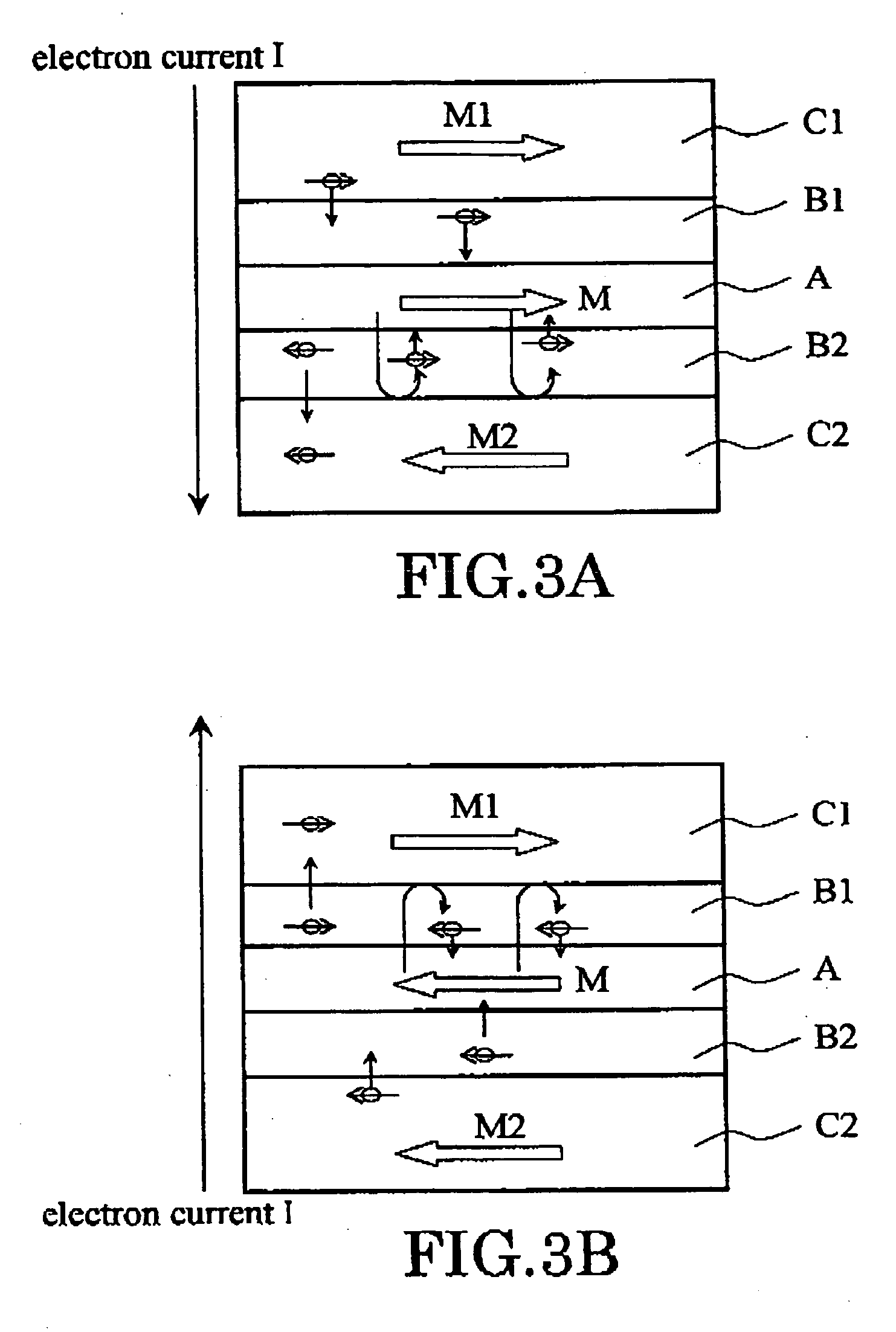Magnetic cell and magnetic memory
a magnetic memory and cell technology, applied in the field of magnetic memory and cell, can solve the problems of insufficient generation of magnetic field, difficult localization,
- Summary
- Abstract
- Description
- Claims
- Application Information
AI Technical Summary
Benefits of technology
Problems solved by technology
Method used
Image
Examples
first embodiment
[0079] FIG. 1 is a schematic diagram which illustrates a fundamental cross-sectional structure of the magnetic cell according to the present invention. This magnetic cell has, two magnetically fixed layers (pinned layer) C1 and C2 whose magnetization directions M1 and M2 are anti-parallel, a magnetic recording layer (free layer) A whose magnetization direction can be changed, and intermediate layers B1 and B2 between the magnetic recording layer A and the magnetically fixed layers.
[0080] The magnetization direction M of the magnetic recording layer A can be controlled by passing current I between the upper magnetically fixed layer C1 and the lower magnetically fixed layer C2. Specifically, the magnetization direction M of the magnetic recording layer A can be reversed by changing direction (polarity) of the flow of the current I. In recording information, "0" and "1" are assigned respectively, according to the magnetization direction M.
[0081] And, in the magnetic cell of the present...
examples
[0217] Hereafter, the embodiment of the invention will be explained in more detail, referring to examples.
first example
[0218] FIG. 29A is a schematic diagram showing the principal cross-sectional structure of the magnetic cell of this example, and FIG. 29B is a schematic diagram showing the principal cross-sectional structure of the magnetic cell of the comparative example.
[0219] That is, the magnetic cell of this example (sample I) has the structure where the electrode EL 1, the magnetically fixed layer C1, the intermediate layer B1, the magnetic recording layer A, intermediate-layer B2, the magnetically fixed layer C2, and the electrode EL 2 are laminated. Moreover, the magnetic cell of the comparative example (sample II) has the structure where the electrode EL 1, the magnetic recording layer A, the intermediate layer B, the magnetically fixed layer C, and the electrode EL2 are laminated. The material and the thickness of each layer are as the following:
[0220] Sample I: EL1(Cu) / C1(Co:20 nm) / B1(Cu:10 nm) / A(Co: 3 nm) / B2(Cu:6 nm) / C2(Co:20 nm) / EL2 (Cu)
[0221] Sample II:EL1(Cu) / A(Co:3 nm) / B(Cu:6nm) / C (...
PUM
 Login to View More
Login to View More Abstract
Description
Claims
Application Information
 Login to View More
Login to View More - R&D
- Intellectual Property
- Life Sciences
- Materials
- Tech Scout
- Unparalleled Data Quality
- Higher Quality Content
- 60% Fewer Hallucinations
Browse by: Latest US Patents, China's latest patents, Technical Efficacy Thesaurus, Application Domain, Technology Topic, Popular Technical Reports.
© 2025 PatSnap. All rights reserved.Legal|Privacy policy|Modern Slavery Act Transparency Statement|Sitemap|About US| Contact US: help@patsnap.com



